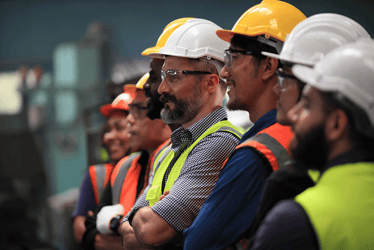The Packaging Industry's Sustainability Challenge: Why ERP Systems Are Essential for Success A straightforward guide to navigating sustainability regulations across folding carton, flexible...
The impact of nearshoring on the Packaging Industry in Mexico
In this article we explore what nearshoring is, why Mexico has emerged as a trading partner powerhouse for the US, and how the Mexican packaging industry can leverage this opportunity.
Contents
- What is nearshoring?
- Why has Mexico emerged as the US’ primary trading partner?
- What Does this mean for the Mexican Packaging Industry?
- Conclusion
What is nearshoring?
Nearshoring is a term used to refer to the practice of relocating a business's (or part of business's) operations to a nearby country. Nearshore emerges typically in response to offshoring, which seeks suppliers in remote locations to cut costs.
The other objective of nearshoring is to bring outsourced production centers closer together and eliminate the costs and/or inefficiencies caused by long distances between continents, which frequently disrupt business processes as part of the supply chain.
Why has Mexico emerged as the US’ primary trading partner?
In 2023, Mexico emerged as the United States' primary trading partner, surpassing even China.
Several key factors have contributed to this shift:
- The introduction of NAFTA (North American Free Trade Agreement), which was implemented in 1994 to encourage trade between the U.S., Mexico, and Canada.
- The onset of the trade conflict between China and the United States during Donald Trump’s administration.
- The continuation of tariffs and trade tensions between the United States and China under Joe Biden’s administration.
- The global pandemic led to increased logistics costs and longer delivery times.
These factors have collectively propelled the Mexican economy to become a nearshoring hub for US consumer goods.
US Imports by Country: 2016 vs. 2023 | U.S. Bureau of Labor Statistics
2016 |
2023 |
||
| China | 20.1% | Mexico | 15.4% |
| Mexico | 13.7% | Canada | 13.9% |
| Canada | 13.1% | China | 13.3% |
| Japan | 6.2% | Germany | 5.3% |
| Germany | 5.4% | Japan | 4.7% |
| South Korea | 3.5% | South Korea | 3.6% |
| United Kingdom | 2.5% | Vietnam | 3.4% |
| France | 2.2% | India | 2.9% |
| India | 2.2% | Ireland | 2.5% |
| Italy | 2.1% | Italy | 2.3% |
| Ireland | 2.0% | United Kingdom | 2.0% |
| Vietnam | 1.9% | Thailand | 1.8% |
| Malaysia | 1.6% | France | 1.8% |
| Switzerland | 1.5% | Switzerland | 1.8% |
| Thailand | 1.3% | Malaysia | 1.6% |
| Brazil | 1.1% | Brazil | 1.2% |
| Indonesia | 0.9% | Indonesia | 1.0% |
| Rest | 18.5% | Rest | 21.3% |
What does this mean for the Mexican Packaging Industry?
There are several sectors in Mexico with significant potential for nearshoring, including:
- Automotive and auto parts
- Computing equipment, communication, measurement, and other electronic components
- Household goods
- Food
All these sectors require packaging solutions, and the combined growth of each sector directly impacts the demand for packaging, both primary and secondary. Over the past years, the average growth rate has been an impressive 9.17%, which is three times higher than the expected 3.0%3 growth rate of the Mexican GDP (PIB).
This poses a significant challenge for packaging producers: how to optimize and increase operations with the same workforce?
Conclusion
ePS’ solutions are designed to enhance the efficiency and scalability of the packaging industry, including tags and labels, folding cartons, and flexible packaging. ePS supports its customers with rapid turnovers, early detection of bottlenecks, and increased productivity. In a rapidly growing market like Mexico's packaging industry, ePS solutions offer a strategic advantage to meet the rising demand efficiently.



